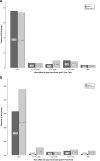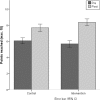Cluster-randomized, controlled evaluation of a teacher led multi factorial school based back education program for 10 to 12-year old children
- PMID: 30257654
- PMCID: PMC6158865
- DOI: 10.1186/s12887-018-1280-y
Cluster-randomized, controlled evaluation of a teacher led multi factorial school based back education program for 10 to 12-year old children
Abstract
Background: The aim of this cluster-randomised, controlled study was to examine whether a teacher-led multifactorial back education programme could improve back pain in pupils, motor skills, back behaviour, and back knowledge over a 10-month period.
Methods: There were 176 children from two schools, who were cluster-randomised into intervention and control groups. The intervention programme consisted of 3 parts: 1) knowledge improvement, 2) posture awareness training, and 3) reducing imbalance of core muscles through mandatory back and abdominal muscle exercises at the beginning of each physical education lesson. Outcome measures included a clinical orthopaedic examination, a health questionnaire, a motor test, a back-behaviour trial, and a knowledge test.
Results: Clinical examination showed a reduction of orthopaedic abnormalities in both groups, from 90.5 to 42%, with a posture test showing an improvement in both groups at the post-test. However, the rate of children reporting back pain at least once a month could not be reduced below 30%. Long lasting physical activity, carrying heavy schoolbags, and long periods of sitting were the top three causes for back pain. Push-up number and balancing skills improved significantly in both groups from pre- to post-test. In the water crate carrying task and knowledge test, only the intervention group (IG) showed a statistically significant improvement from pre- to post-test.
Conclusions: The results show that back pain rate could not be decreased. However, back care knowledge and parts of back-friendly behaviour could be significantly improved. On the other hand, the problem of prolonged sitting and using heavy schoolbags persists.
Trial registration: Deutsches Register Klinische Studien DRKS00013794 ; Date of Registration: 15.1.2018; Retrospectively registered.
Keywords: Back education; Back pain; Children; Controlled; Prevention.
Conflict of interest statement
Ethics approval and consent to participate
The study was conducted according to the guidelines of the declaration of Helsinki. The ethical approval was obtained from the Ethical Board of the University Clinic of Regensburg. Parental consent was obtained in written format.
Consent for publication
Not applicable.
Competing interests
The authors declare that they have no competing interests.
Publisher’s Note
Springer Nature remains neutral with regard to jurisdictional claims in published maps and institutional affiliations.
Figures







References
-
- GBD 2015 Disease and Injury Incidence and Prevalence Collaborators Global, regional, and national incidence, prevalence, and years lived with disability for 310 diseases and injuries, 1990-2015. a systematic analysis for the global burden of disease study 2015. Lancet. 2016;388(10053):1545–1602. doi: 10.1016/S0140-6736(16)31678-6. - DOI - PMC - PubMed
Publication types
MeSH terms
Associated data
LinkOut - more resources
Full Text Sources
Other Literature Sources
Medical
Molecular Biology Databases

